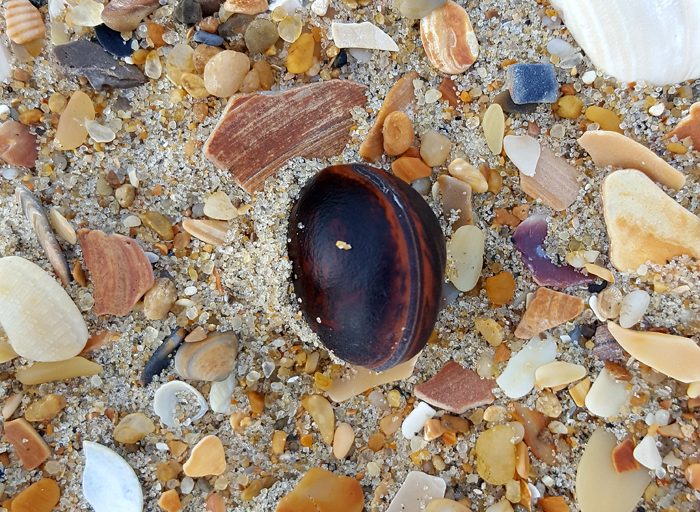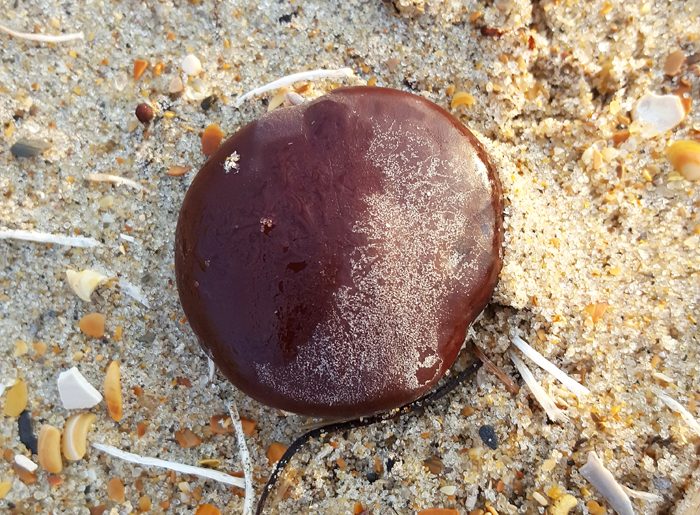
Hurricanes and tropical storms have been forming and reshaping the ribbon of sand known as the Outer Banks since its creation. After one of these storms passes by the Atlantic coast, beachcombers from all over flock to the shores with hopes of finding bountiful treasures. One of these unusual treasures that can make a rare appearance, especially after a storm, are sea beans.
Sea beans come from the Rainforest or other tropical regions of the globe. The “beans” aren’t actually beans, but are usually seeds, (and sometimes actual fruit), that fall from tropical plants into rivers, like the Amazon. Rivers from around the world carry the seeds to the ocean, and the ocean carries them onward, over hundreds and sometimes thousands of miles of open waters until they meets the next body of land.
Sea beans have a very hard surface, which provides protection to the actual seeds inside the bean. The seeds have pockets of air inside, and these air pockets provide the sea bean with its buoyancy. Its strong exterior and ability to float make the sea bean tough enough to survive the incredible journey over the vast, harsh ocean.
There are a wide variety of sea beans, and we will highlight a few of the more common ones that can be found along the Outer Banks, starting with the largest on to find, the sea heart. The sea heart can be found up to 12 inches wide, and inside each are 10 to 15 seeds. The seeds are hollow and provide the bean with buoyancy which can last up to two years. The sea heart is shaped like a heart, giving the bean its name, and it’s typically a deep burgundy color.
Another popular one to find, but not as common or as large as the sea heart, is the hamburger bean. There are hundreds of types of hamburger beans that come from a wide variety of tropical plant life. The hamburger bean gets its name because it looks like sandwich buns with meat in the middle. Some are light brown with a dark brown middle, and others are dark brown with a rusty-colored center.
There are also sea coconuts known as “golf balls.” They are round sea beans, unlike the sea heart and hamburger bean, which are flatter. They typically are the size of golf balls and are hollow in the center. On rare occasions you can find these with their popcorn-looking coating still attached.
Sea beans are amazing to find and are so unusual that, throughout the ages, many believed that they brought good luck to whoever found one. The legend is that you carry the bean in your pocket and rub your worries or your wishes onto it. Simply by rubbing it over time, the oils from your hand transfer onto to the bean, and it naturally becomes shiny. It’s believed that by doing this, the bean will lock your worries in, making them vanish, or the bean will capture your wish in order to make it come true.
These sea beans are also used to make jewelry and other decorative items throughout the generations. When they are first found, they are usually frosty and dull, similar to the way seaglass looks, but these beans can easily be polished. Any type of oil, like mineral oil, will give them a beautiful shine. It’s also a good idea to wash them in dish soap, because they have traveled such long distances, and sometimes have leftover muscles attached to the outside exterior.
So the next time you find yourself beachcombing after a tropical storm, be on the lookout for these amazing, long distance travelers. You might be able to go home with a little piece of the Amazon, or some other distant, tropical destination, that’s miles away from the Outer Banks!




